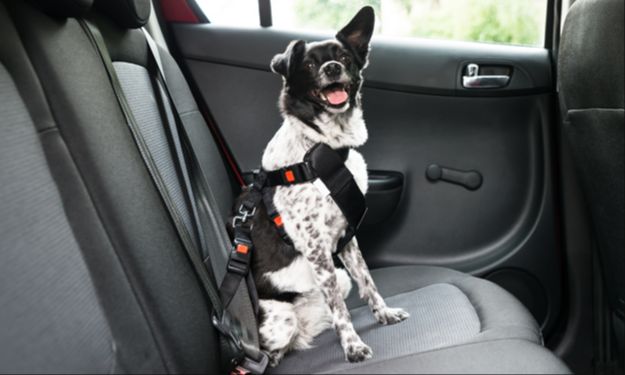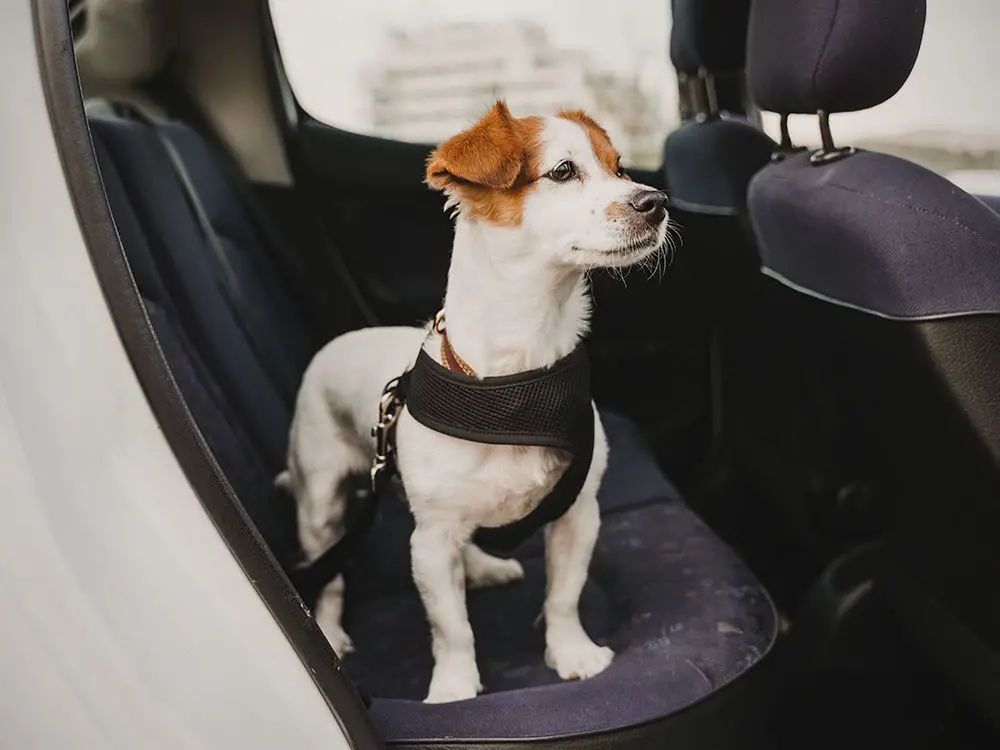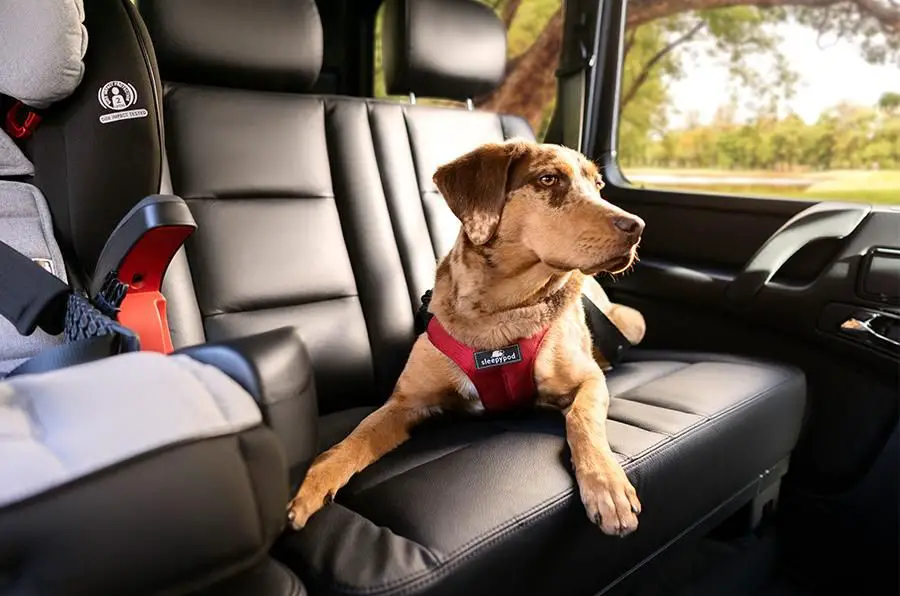Introduction
Using a dog seat belt restraint while traveling in a vehicle is one of the most important things you can do to keep your furry friend safe. Unrestrained dogs in a moving car can become dangerous projectiles in the event of a crash or sudden stop. According to the American Humane Society, an unrestrained 10-pound dog will exert around 500 pounds of force in a 50 mph crash. Restraining your dog prevents them from interfering with the driver or becoming injured from being thrown around the vehicle.
Dog seat belt restraints come in various types, but they all serve the same essential functions – preventing distraction and limiting your dog’s movement. When used properly with a well-fitted harness, they can make car trips significantly safer for both you and your pet. This guide will cover how to choose the right restraint for your dog, ensure proper fit, attach the restraint correctly, train your dog to accept the restraint, and travel safely together.
Choosing the Right Restraint
The most important part of using a dog restraint is picking one that properly fits your dog. You’ll want to consider your dog’s size and weight, as well as the type of vehicle you’ll be traveling in. Restraints come in a variety of styles to accommodate different needs.
For small dogs under 15-20 pounds, you can often use a harness that attaches directly to the seat belt in either the front or back seat. Medium and large dogs will require a restraint that anchors to the car’s seat brackets or floor using specially designed hardware.
Measure your dog to find the right size, and look at weight recommendations to ensure the restraint will properly restrict your dog’s movement in an accident. Also consider your vehicle – a restraint made for the backseat of a sedan won’t work in an SUV, for example. Pick a restraint made specifically for your make and model.

Look for crash-tested models that meet federal safety standards. This ensures the restraint will function properly in an emergency. Avoid gimmicky or novelty restraints, as these often will not provide adequate protection.
Proper Fit
When fitting your dog with a seat belt restraint, it’s important to find a good balance between security and comfort. The restraint should be snug enough to prevent your dog from roaming around the car or being projected forward in an accident, but not so tight as to restrict their breathing or movement while sitting or lying down. As a general rule, you should be able to fit two fingers between the restraint and your dog’s collar or harness.
Ideally, the restraint should limit your dog’s movement to a few inches in any direction. They should be able to sit up, turn their head, and reposition themselves, but not stand up, walk around, or jump into the front seat. Adjustable straps help you customize the fit based on your dog’s size and shape. Test out their range of motion before driving to ensure the restraint is secure but allows for adequate mobility. With the right snug fit, your dog can ride safely without discomfort or restriction.
Attachment Methods
There are a few common methods for attaching dog seat belt restraints in your vehicle:
Latch Bar
Many newer vehicles have latch bars built into the seats to secure child safety seats. You can attach certain dog restraints to these latch bars for a very secure fit. Look for latch bar attachments near the seat crease. Make sure to only use latch bars approved for use with pet restraints, as the forces involved are different than with child seats.
Seat Belt Loop
Most dog seat belts have a reinforced loop that slides over your existing vehicle seat belt. Pass the seat belt through the loop and buckle it in as usual. This keeps your pet attached securely to the seat belt system. Check that the loop is robust enough to withstand force without breaking.
Headrest Attachment
Some restraints have straps that attach to the vehicle’s headrest posts. This keeps the restraint and your dog in the back seat. Make sure the straps are adjustable and sturdy for a snug fit. Only use them on headrests designed for such attachments.
Putting On the Restraint
Putting on a dog seat belt restraint properly is crucial for ensuring your dog’s safety while traveling. The exact steps will vary slightly depending on the type of restraint you have.
Step-by-Step for a Vest Harness Restraint
For a vest harness restraint:
- Lay the harness flat and unclip all the straps.
- Have your dog step into the harness, making sure their legs go through the right openings.
- Pull the harness up over your dog’s back and clip the straps closed so it fits snugly.
- Attach the seat belt tether to the clip on the back of the harness.
- Buckle the seat belt into the car’s buckle.
- Pull any excess tether strap through the buckle so it’s tight.

Step-by-Step for a Dog Collar Restraint
For a collar restraint:
- Unbuckle the seat belt and thread it through the loop on the restraint collar.
- Place the collar around your dog’s neck and buckle it, ensuring a snug fit.
- Buckle the seat belt through the restraint loop and into the car’s buckle.
- Pull any excess tether strap through the buckle to tighten.
Take your time with this process and get your dog comfortable with having the restraint put on. Make sure it’s snug but not too tight. Give your dog pets and praise for being patient during the process.
Riding Positions
The ideal placement for your dog when using a seat belt restraint is near the rear center seat. For owners who drive SUVs, hatchbacks, wagons, or other cars without a rear bench, the center area behind the two front seats is optimal. However, your dog should not be placed in very back cargo area, only in a rear passenger seat.
Having your dog on one side of the backseat can be dangerous in an accident or sudden stop. The dog could be thrown against the door or footwell, risking injury. A central position behind the front seats helps prevent this. It also allows you to reach your dog more easily to provide reassurance.
If placing your dog in the middle isn’t possible, positioning them behind the front passenger seat is the next safest option. Avoid having them behind the driver’s seat, which puts them at higher risk of impact from the steering wheel or driver in an accident.
Make sure to avoid having any slack in the restraint. Your dog should not be able to move more than a foot or two side-to-side or front-to-back. Keeping the leash tight prevents your dog from interfering with or distracting the driver.
Added Safety Measures
Using a dog seat belt restraint properly is crucial for safety, but there are additional precautions you can take:

-
Use harnesses designed for travel that distribute force across the chest and shoulders. Collars can put too much pressure on the neck.
-
Secure crates with straps or anti-slide mats to prevent shifting in the car.
-
Install sturdy barriers between the front and back seats to prevent your dog from jumping into the front.
Take every effort to restrain your dog and restrict their movement. An unrestrained dog in a moving vehicle can be dangerous for both you and your pet.
Training Your Dog
Getting your dog accustomed to wearing a seat belt restraint is an important part of the process. Some dogs may resist or be anxious about having something attached to their collar or harness at first. Take the time to gently introduce the restraint and train them to accept wearing it:
- Start by simply laying the restraint near your dog so they can inspect it.
- Next, attach the restraint to their collar or harness for just a few minutes at a time, rewarding them with treats for calm behavior.
- Take short car rides of 5-10 minutes with the restraint on, praising and rewarding the dog for remaining settled.
- Gradually increase the duration of wearing the restraint during rides. Always keep sessions positive and end on a good note if the dog becomes agitated.
- Be patient and consistent during the training process. Forcing a dog to wear a restraint will only increase anxiety. Make it a positive experience.
With time and positive reinforcement, your dog will become comfortable wearing their seat belt restraint in the car.
Traveling Safely
When traveling with a dog in the vehicle, following proper safety procedures is essential. Here are some tips for traveling safely with your canine companion:
Obey all traffic laws and speed limits. Drive cautiously and defensively, being aware of your surroundings. Avoid distractions like cell phones.

Focus your attention on the road at all times. Driving with an unrestrained dog can be dangerous as they can become a distraction.
Brake early and slowly to avoid sudden jerking movements that could injure your unrestrained dog. Take turns gradually.
Be prepared to pull over if your dog becomes agitated, ill or disruptive. Never reach into the backseat while driving.
Ensure your dog has access to water to prevent dehydration on longer trips. Stop every 2-3 hours for potty and exercise breaks.
Avoid harsh accelerations, stops or turns. Drive smoothly for the comfort and safety of your dog.
Check on your dog frequently using your rearview mirror. Be prepared to provide veterinary care if they become carsick or hurt.
Follow these safe driving practices, along with proper restraint use, for the best travel experience with your dog.
Conclusion
In summary, properly using a dog seat belt restraint is essential for keeping your dog safe while traveling in a vehicle. Start by selecting an appropriate harness or vest-style restraint that fits your dog well and attaches securely to your vehicle. Take the time to properly fit and adjust the restraint to your dog before each trip. Attach the restraint using sturdy metal clips to either a seat belt or latch, ensuring your dog has some movement but cannot roam freely. Position your dog to lay down or sit up depending on breed and comfort level. Always double check that the restraint is securely fastened before starting your trip. With proper usage, a dog seat belt restraint can greatly reduce the risk of injury in an accident and prevent driver distraction. Keeping your dog properly secured allows you to focus on the road and arrive safely at your destination.